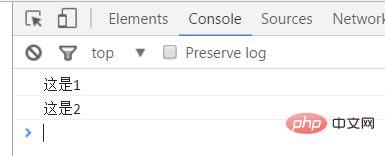What is the difference between onload and load in JavaScript?
Difference: load only indicates the event method, but is not executed; onload indicates that it will be executed after loading everything on the page. Only one onload function is allowed to appear on the page because it only has one programmable function. onload may be executed before some elements are loaded, and load will be executed after all elements are loaded.

Related recommendations: "jQuery Video Tutorial"
When writing interactions, whether the loading function should be onload or load Woolen cloth?
Take the opportunity to organize it so you don’t forget it! !
window.onload(function) in js is equivalent to $(window).onload(function) in jquery
1: window.load only indicates the event method, but it is not executed. For example, hover and click represent events, and hover and onclick must be used before they will be executed.
There is usually a Loading effect when the page is loaded and rendered, and you can use it at this time:
JS:
$(window).load(function(){
$(".loadingicon").addClass("loader-chanage");
$(".loadingicon").fadeOut(300,function(){
$(".loadingicon").remove();
$(".maker").show().animate({"right":"0"},500);
});
})$(window).load(function) The images and other resources in the page will not be executed until they are loaded;
2: window.onload means that the loading is complete Everything on the page is executed only after everything is executed. Only one onload function is allowed to appear on the page, because it only has one programmable function:
JS:
<!DOCTYPE html>
<html lang="en">
<head>
<meta charset="utf-8">
<title>demo float</title>
</head>
<body>
<script type="text/javascript">
window.onload = function(){ alert("这是1");};
window.onload = function(){ alert("这是2");};
</script>
</body>
</html>Running result:

Three: After talking about the above, there is another Jquery $(document).ready(function), which is executed after all the DOM structures in the web page are drawn. Maybe the content associated with the DOM elements has not been loaded. , such as pictures and related height and width settings, etc. At this time, you can consider the load method in jquery to avoid it; in addition, $(document).ready(function) can write unlimited functions, such as:
<!DOCTYPE html>
<html lang="en">
<head>
<meta charset="utf-8">
<title>demo float</title>
<script type="text/javascript" src="http://static.ruilife.net/static/js/jquery-1.9.1.min.js"></script>
</head>
<body>
<script type="text/javascript">
$(document).ready(function(){ console.log("这是1");});
$(document).ready(function(){ console.log("这是2");});
</script>
</body>
</html>Running results:

4. document
document.write(_LoadingHtml);
//监听加载状态改变
document.onreadystatechange = completeLoading;
//加载状态为complete时移除loading效果
function completeLoading() {
if (document.readyState == "complete") {
var loadingMask = document.getElementById('loadingp');
loadingMask.parentNode.removeChild(loadingMask);
}
}Finally summarize:
js: This function will be executed as soon as the window.onload page is run. , when executing this function, the images in the page may not be loaded yet!
jquery: This function is executed after the images or other things in the $(window).load() page are loaded.
The complete format of calling the load method is: load(url, [data], [callback]) The parameters are respectively url address, file type (php, html, etc.), callback function, and also supports selector loading load( "test.html #content id name")
For more programming-related knowledge, please visit: Programming Teaching! !
The above is the detailed content of What is the difference between onload and load in JavaScript?. For more information, please follow other related articles on the PHP Chinese website!

Hot AI Tools

Undresser.AI Undress
AI-powered app for creating realistic nude photos

AI Clothes Remover
Online AI tool for removing clothes from photos.

Undress AI Tool
Undress images for free

Clothoff.io
AI clothes remover

AI Hentai Generator
Generate AI Hentai for free.

Hot Article

Hot Tools

Notepad++7.3.1
Easy-to-use and free code editor

SublimeText3 Chinese version
Chinese version, very easy to use

Zend Studio 13.0.1
Powerful PHP integrated development environment

Dreamweaver CS6
Visual web development tools

SublimeText3 Mac version
God-level code editing software (SublimeText3)

Hot Topics
 How to implement an online speech recognition system using WebSocket and JavaScript
Dec 17, 2023 pm 02:54 PM
How to implement an online speech recognition system using WebSocket and JavaScript
Dec 17, 2023 pm 02:54 PM
How to use WebSocket and JavaScript to implement an online speech recognition system Introduction: With the continuous development of technology, speech recognition technology has become an important part of the field of artificial intelligence. The online speech recognition system based on WebSocket and JavaScript has the characteristics of low latency, real-time and cross-platform, and has become a widely used solution. This article will introduce how to use WebSocket and JavaScript to implement an online speech recognition system.
 WebSocket and JavaScript: key technologies for implementing real-time monitoring systems
Dec 17, 2023 pm 05:30 PM
WebSocket and JavaScript: key technologies for implementing real-time monitoring systems
Dec 17, 2023 pm 05:30 PM
WebSocket and JavaScript: Key technologies for realizing real-time monitoring systems Introduction: With the rapid development of Internet technology, real-time monitoring systems have been widely used in various fields. One of the key technologies to achieve real-time monitoring is the combination of WebSocket and JavaScript. This article will introduce the application of WebSocket and JavaScript in real-time monitoring systems, give code examples, and explain their implementation principles in detail. 1. WebSocket technology
 How to implement an online reservation system using WebSocket and JavaScript
Dec 17, 2023 am 09:39 AM
How to implement an online reservation system using WebSocket and JavaScript
Dec 17, 2023 am 09:39 AM
How to use WebSocket and JavaScript to implement an online reservation system. In today's digital era, more and more businesses and services need to provide online reservation functions. It is crucial to implement an efficient and real-time online reservation system. This article will introduce how to use WebSocket and JavaScript to implement an online reservation system, and provide specific code examples. 1. What is WebSocket? WebSocket is a full-duplex method on a single TCP connection.
 How to use JavaScript and WebSocket to implement a real-time online ordering system
Dec 17, 2023 pm 12:09 PM
How to use JavaScript and WebSocket to implement a real-time online ordering system
Dec 17, 2023 pm 12:09 PM
Introduction to how to use JavaScript and WebSocket to implement a real-time online ordering system: With the popularity of the Internet and the advancement of technology, more and more restaurants have begun to provide online ordering services. In order to implement a real-time online ordering system, we can use JavaScript and WebSocket technology. WebSocket is a full-duplex communication protocol based on the TCP protocol, which can realize real-time two-way communication between the client and the server. In the real-time online ordering system, when the user selects dishes and places an order
 Simple JavaScript Tutorial: How to Get HTTP Status Code
Jan 05, 2024 pm 06:08 PM
Simple JavaScript Tutorial: How to Get HTTP Status Code
Jan 05, 2024 pm 06:08 PM
JavaScript tutorial: How to get HTTP status code, specific code examples are required. Preface: In web development, data interaction with the server is often involved. When communicating with the server, we often need to obtain the returned HTTP status code to determine whether the operation is successful, and perform corresponding processing based on different status codes. This article will teach you how to use JavaScript to obtain HTTP status codes and provide some practical code examples. Using XMLHttpRequest
 JavaScript and WebSocket: Building an efficient real-time weather forecasting system
Dec 17, 2023 pm 05:13 PM
JavaScript and WebSocket: Building an efficient real-time weather forecasting system
Dec 17, 2023 pm 05:13 PM
JavaScript and WebSocket: Building an efficient real-time weather forecast system Introduction: Today, the accuracy of weather forecasts is of great significance to daily life and decision-making. As technology develops, we can provide more accurate and reliable weather forecasts by obtaining weather data in real time. In this article, we will learn how to use JavaScript and WebSocket technology to build an efficient real-time weather forecast system. This article will demonstrate the implementation process through specific code examples. We
 How to get HTTP status code in JavaScript the easy way
Jan 05, 2024 pm 01:37 PM
How to get HTTP status code in JavaScript the easy way
Jan 05, 2024 pm 01:37 PM
Introduction to the method of obtaining HTTP status code in JavaScript: In front-end development, we often need to deal with the interaction with the back-end interface, and HTTP status code is a very important part of it. Understanding and obtaining HTTP status codes helps us better handle the data returned by the interface. This article will introduce how to use JavaScript to obtain HTTP status codes and provide specific code examples. 1. What is HTTP status code? HTTP status code means that when the browser initiates a request to the server, the service
 How to use insertBefore in javascript
Nov 24, 2023 am 11:56 AM
How to use insertBefore in javascript
Nov 24, 2023 am 11:56 AM
Usage: In JavaScript, the insertBefore() method is used to insert a new node in the DOM tree. This method requires two parameters: the new node to be inserted and the reference node (that is, the node where the new node will be inserted).






